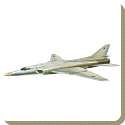 Tupolev Tu-22M — The Tupolev Tu-22M (NATO reporting name: Backfire) is a supersonic, swing wing, long-range strategic and maritime strike bomber developed by the Soviet Union. Significant numbers remain in service with the Russian Air Force.
Tupolev Tu-22M — The Tupolev Tu-22M (NATO reporting name: Backfire) is a supersonic, swing wing, long-range strategic and maritime strike bomber developed by the Soviet Union. Significant numbers remain in service with the Russian Air Force.
Development
The Tupolev Tu-22 had not proved particularly successful, in some respects being inferior to the earlier Tu-16. Its range and takeoff performance, in particular, were definite weak points. Even as the Tu-22 was entering service, OKB Tupolev began work on an improved successor.
As with the contemporary MiG-23 and Su-17 projects, the advantages of variable-geometry wings seemed attractive, allowing a combination of short takeoff performance, efficient cruising, and good high-speed, low-level ride. The result was a new swing wing aircraft called Samolyot 145 (Rus. Aeroplane 145), derived from the Tu-22, with some features borrowed from the abortive Tu-98. The Tu-22M was based on the Tu-22’s weapon system and used its Kh-22 missile. The Tu-22M designation was used to help get approval for the bomber within the Soviet system.
The first prototype, Tu-22M0, first flew on 30 August 1969. The resultant aircraft was first seen by NATO observers shortly thereafter. For several years it was believed in the West that its service designation was Tu-26. During the SALT negotiations of the 1980s the Soviets insisted it was the Tu-22M. At the time, Western authorities suspected that the misleading designation was intended to suggest that it was simply a derivative of the Tu-22 rather than the more advanced and capable weapon it actually was.
Operational History
During the Cold War, the Tu-22M was operated by the VVS (Soviet Air Force) in a strategic bombing role, and by the AVMF (Aviatsiya Voyenno-Morskogo Flota, Soviet Naval Aviation) in a long-range maritime anti-shipping role. During the 1970s, Tu-22M made a few simulated attack runs against US navy carrier battle group. The bomber also made attempts to test Japan’s air defense boundary on several occasions. However unlike the Tu-22 bomber, Tu-22M bombers were not exported to middle-east countries that posed threat to US military presence in the region.
The Tu-22M was first used in combat in Afghanistan from 1987 to 1989. Its usage was similar to the United States Air Force deployment of B-52 Stratofortress bombers in the Vietnam War, dropping large tonnages of conventional ordnance. The Russian Federation used the Tu-22M3 in combat in Chechnya during 1995, performing strikes near Grozny.
At the time of the dissolution of the Soviet Union, some 370 remained in CIS service. Production ended in 1993. The fleet strength was about 84 aircraft in 2008, with an additional 93 in reserve.
The Russian military officially acknowledged the loss of a Tu-22MR recon aircraft to Georgian air defenses early in the 2008 South Ossetia war. One of its crew members was captured (Major Vyacheslav Malkov), two others were killed and the crew commander is missing in action as of August 2009.
Export
The Soviet Union did not export the Tu-22M, but the end of the USSR left some aircraft in the possession of former Soviet republics. Belarus has 52 aircraft. Ukraine had an additional 29, but since the Ukrainian government’s renunciation of nuclear weapons, those aircraft have been destroyed, the last in 2004.
The Tupolev company has sought export customers for the Tu-22M since 1992, with possible customers including Iran, India and the People’s Republic of China, but no sales have apparently been made. Four were leased to India during 2001 for maritime reconnaissance and strike purposes.
 Kids Portal For Parents India Kids Network
Kids Portal For Parents India Kids Network
